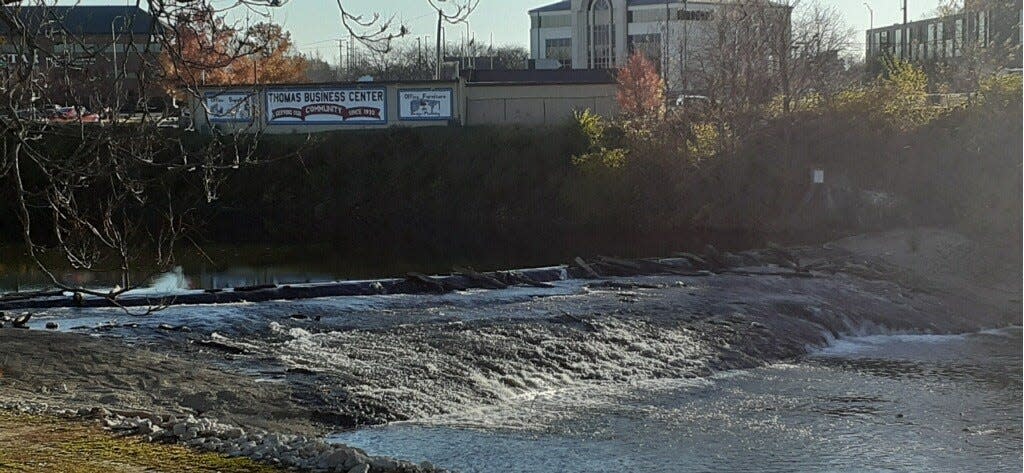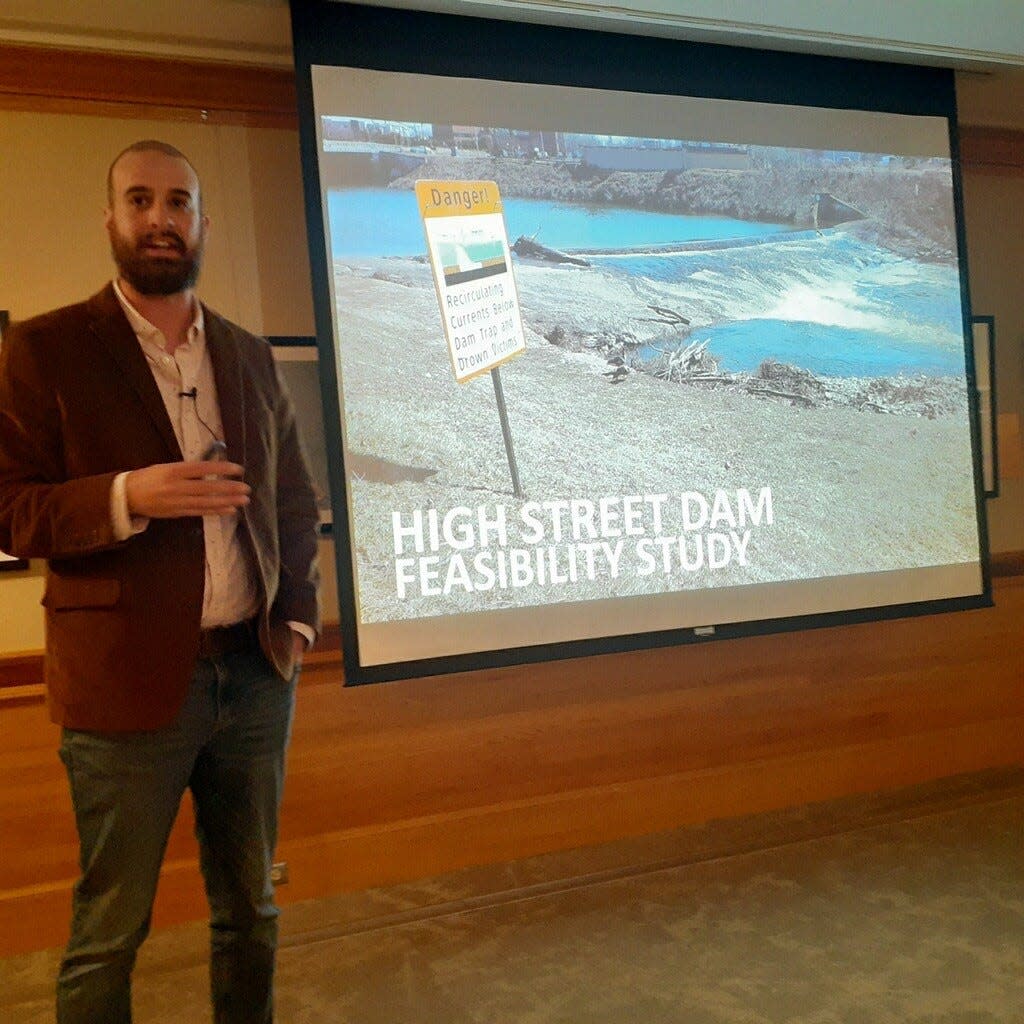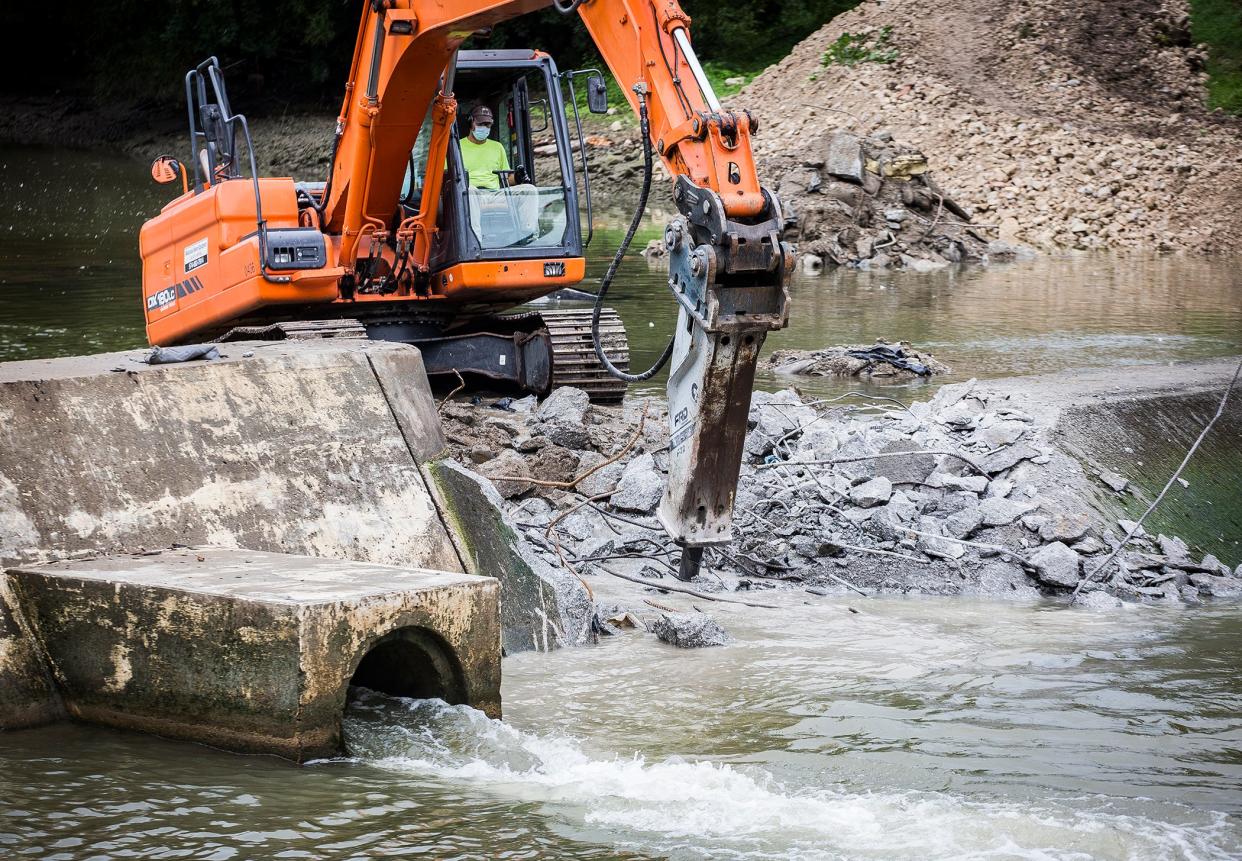Profound changes in White River downtown could flow from dam study
MUNCIE, Ind. – White River along northbound Wheeling Avenue at Christmastime dazzles as holiday lights reflect off the broad river's surface. But that view seems likely to change at some point this decade.

The days of High Street Dam as it has been known and its impact on the river downtown seem numbered.
For 113 years the river has been widened and slowed west of the Walnut Street bridge. It calmly coasts around a bend and makes its way beneath the Muncie Central high School athletic fields and parking for the Muncie Fieldhouse. The water, having risen due to the dam, appears almost as a placid lake.
The river bends lazily under the Fallen Heroes Memorial Bridge at High Street, after which it meets the aging obstruction. The dam has created the look of the river in downtown Muncie for more than a century.
But the dam is nearing the end of its life, say experts now studying what needs to happen with the structure. It was built in 1910 to pool river water for an intake to an Indiana Michigan Power plant that stood where Muncie City Hall stands today.
"It no longer has a purpose," said David Heilman of FlatLand Resources, the design company that has worked to eliminate or alter the four other dams inside the city. FlatLand is working on a study about the structure in conjunction with Delaware County Soil and Water Conservation and the Indiana Department of Natural Resources.
The I&M plant left decades ago. In 1955 the utility offered to remove the dam but the city opted to take ownership instead. In recent years, a Muncie Sanitary District study said the cost to remove the seven-foot deep dam was about $3 million.

Phil Tevis, head of FlatLand Resources, said that the dam has been heading toward failure, with water flowing around the dam at its sides at times. Failure could lead to property damage as well as endanger people. He said that the city would be liable for any damage caused.
"That dam is going to fail," he said, with assurance.
Issues surrounding the structure are complicated, explained Heilman during a public meeting conducted last week as part of the study.

If nothing is done, Heilman said the city would have to absorb all the financial risk alone for a pending dam failure. Should it be determined to replace the dam, it would be expensive and it would be difficult to obtain permits and outside funding because there is no longer a need for a dam at that location.
Muncie Mayor Dan Ridenour said last week that he is aware of the issue and acknowledges the dam won't last forever.
"It certainly would lower the water level," Ridenour said of taking the dam out.
But whatever the city does, it will need help financially to make the change, he said.
Federal and state grants are available to remove or partially eliminate the dam. Total removal would help return the river to its natural state.
Without the dam, the river level will drop as it moves through downtown. Heilman said. It will become narrower, and banks will move closer to one another. The river will look more like it does as it heads into Muncie and through the areas, near Jackson Street and also at at McCulloch Park, where dams were taken out in recent years.
The High Street dam is the final obstruction to be dealt with along White River in Muncie. The city had five dams, which have since been altered or removed to return the river to its more natural state − a more shallow flow of water, friendly to canoeists and kayakers and to small mouth bass and blue heron.

However, some form of obstruction will be needed. North and east of the Fallen Heroes Memorial Bridge the depth of the water needs to remain above a large sewer pipe running under the water that takes sewage from the east side of the city on toward the sewage plant on the west side.
Heilman said the pipe, located before the river bends and goes under the bridge, would be exposed if the river went to its natural depth there. Rip rap and other types of rock can be placed in the river in a step fashion to raise the water level enough to conceal the sewer pipe.
Ridenour said he is waiting for the study to be completed but suspects that a partial dam removal, allowing more water to pass but still aiding in keeping the depth high enough to cover the sewer pipe, will eventually be the remedy.
But the mayor says the issue will need to be fully examined with much public comment following the study before a decision is made.
Heilman said it would likely be 2027 before whatever is determined to do with the dam actually takes place.
The city has invested in White River as a draw for downtown development, including the creation of a "canal district" west of City Hall. The city has incentivized private development of apartments and is looking for more restaurants and bars in the area of the river.

Ridenour said the removal or diminishing of the dam will change the look of the river a bit but he thinks the views will still be visually appealing.
Heilman noted that dams like the High Street Dam are dangerous for canoeists and kayakers as water goes over the dams and rotates back toward the dam, making swimming difficult in the foaming back current.
Modifications were made to a dam at the Indiana American water plant and at the Muncie Sanitary District by Flatland, which works on several projects aimed at improving river life and recreation in Muncie. The IAWC water utility for Muncie intakes 2.6 million gallons of water a day or about 20% of the river flow through Muncie, he said.
People attending the meeting said the river in the city is more often used now for fishing as opposed to a time a few decades ago when industrial waste flowed into the river. It carried unappealing odors and disturbing colors for a river and was inhospitable to wildlife.
John M. Craddock, director emeritus of the Bureau of Water Quality and the man often credited as leading the effort to clean White River in Delaware County, said he supports removal of the dam to further allow aquatic life to return to its natural state before people dammed up the river.

It will take time for the river to return to its more native state − about 75 to 100 years.
What we do now will be something that people generations from now will gain the benefit from, Ridenour said. But something will have to be done.
"It's going to eventually fall apart," Ridenour said about the High Street Dam. "That's what things do."
David Penticuff is a reporter with The Star Press. He can be reached at dpenticuff@gannett.com.
This article originally appeared on Muncie Star Press: Profound changes in White River downtown could flow from dam study
